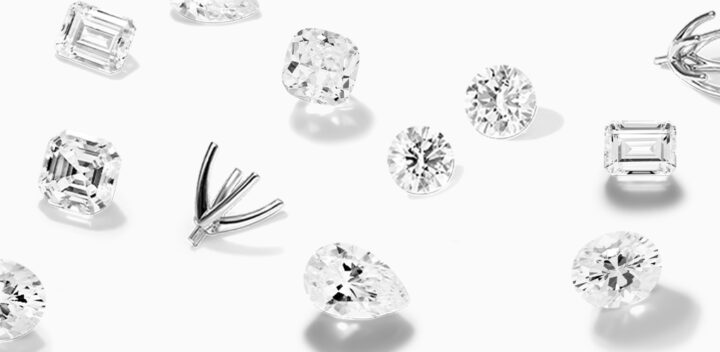Lab-grown diamond rings have become increasingly popular in recent years, offering an ethical and affordable alternative to naturally mined diamonds. As more consumers prioritize sustainability and value, lab-grown diamonds have gained significant traction in the jewelry market. In this comprehensive shopper’s guide, we will delve into the key considerations when purchasing lab-grown diamond rings.
From understanding the basics of their production to evaluating quality, exploring various designs, and considering ethical factors, we will equip you with valuable insights to make an informed and satisfying purchase decision.
Understanding the basics: How lab-grown diamonds are made.

Lab grown engagement rings are created through a fascinating scientific process that replicates the natural formation of diamonds. High-pressure high-temperature (HPHT) and chemical vapor deposition (CVD) are the two main methods used to grow these diamonds in a controlled environment.
Both methods involve subjecting a gem seed to extreme heat and pressure, allowing carbon atoms to arrange themselves into the crystal lattice structure that makes diamonds unique. It is crucial to understand these production methods to assess the quality and authenticity when shopping.
Setting a budget: Factors to consider before buying.
Before embarking on your purchase, it is essential to establish a budget that aligns with your financial capacity and preferences. Factors that influence the price include the diamond’s carat weight, color, clarity, and cut, as well as the metal used for the band and any additional design features.
By setting a budget, you can narrow down your options and focus on finding the best value within your price range. Remember that they often offer significant cost savings compared to their natural counterparts, making them an attractive choice for budget-conscious shoppers.
Choosing the right diamond shape and size.

The shape and size you choose are highly personal decisions that depend on your style, preference, and the wearer’s hand shape. Popular shapes include round brilliant, princess, cushion, emerald, and pear, among others.
Consider the recipient’s style and personality to select a shape that reflects their individuality. Additionally, the size of it, measured in carats, influences its visual impact. Remember that size is not solely determined by carat weight but also by the cut, as certain cuts can make the stone appear larger.
Evaluating diamond quality: The 4Cs and beyond.
When assessing the quality, it is crucial to understand the 4Cs: carat weight, color, clarity, and cut. Carat weight determines the size, while color refers to the presence of any tint.
Clarity examines the presence of internal or external flaws, and cut determines the diamond’s brilliance and sparkle. Beyond the 4Cs, additional factors like fluorescence and symmetry can impact overall quality. Familiarize yourself with these factors to ensure you make an informed decision and choose a high-quality that meets your expectations.
Selecting the perfect metal band for your ring.
The metal band plays a vital role in its overall appearance and durability. Common choices include platinum, gold, white gold, and rose gold, each offering unique characteristics. Platinum, known for its durability and hypoallergenic properties, is an excellent option for those seeking a long-lasting ring. Gold, available in various colors, offers a timeless appeal and can complement different skin tones. Consider your lifestyle, budget, and personal style when selecting the metal band, ensuring it harmonizes with the chosen gem and stands the test of time.
Examining different settings and designs for lab-grown diamond rings.

The setting and design of a lab-grown stone ring greatly influence its aesthetic appeal and functionality. Popular settings include prong, pave, channel, bezel, and halo, each providing distinct looks and levels of security for the stone. It’s essential to consider the wearer’s lifestyle and preferences to choose a setting that suits their needs.
Additionally, explore various design elements like side stones, engravings, and unique band shapes to create a truly personalized and eye-catching ring. Don’t be afraid to experiment with different combinations to find the perfect design that speaks to you or your loved one.
Considering ethical and environmental factors in your purchase.
One of the significant advantages of lab-grown diamonds is their ethical and environmental footprint. Unlike mined gems, which may be associated with human rights concerns and environmental damage, they are conflict-free and require fewer resources to produce.
When purchasing a lab-grown diamond ring, inquire about the manufacturer’s commitment to sustainability and ethical practices. Look for certifications such as the Kimberley Process Certification Scheme and Responsible Jewelry Council to ensure the gems origin and ethical integrity.
Researching reputable retailers and trusted certification agencies.

To ensure a successful lab-grown diamond ring purchase, it is crucial to research and choose reputable retailers and trusted certification agencies. Look for established jewelers with a track record of providing quality products and exceptional customer service. Verify their credentials, read customer reviews, and inquire about their selection of lab-grown diamonds.
Similarly, certification agencies such as the Gemological Institute of America (GIA) and the International Gemological Institute (IGI) offer independent assessments of a diamond’s quality and authenticity. Choosing a retailer and certification agency that prioritizes transparency and expertise will give you peace of mind during your purchase.
Understanding warranties, guarantees, and return policies.

Before finalizing your lab-grown diamond ring purchase, carefully review the retailer’s warranties, guarantees, and return policies. Understand the terms and conditions regarding repairs, resizing, and maintenance services.
Familiarize yourself with the warranty coverage and any additional fees that may apply. Furthermore, ensure that the retailer offers a reasonable return policy, allowing you to exchange or return the ring if it doesn’t meet your expectations. Clear communication and transparency in these areas will safeguard your investment and provide reassurance throughout the lifespan of your lab-grown diamond ring.
Final tips for a successful lab-grown diamond ring purchase.
In conclusion, buying a lab-grown stone ring can be an exciting and rewarding experience. Remember to conduct thorough research, set a budget, and consider the diamond’s shape, size, and quality. Pay attention to the metal band, setting, and design to create a ring that perfectly embodies your style and preferences.
Prioritize ethical and environmental factors by choosing lab-grown gems and researching reputable retailers and certification agencies. Finally, review warranties, guarantees, and return policies to ensure a seamless buying experience. Armed with these tips and tricks, you’re now ready to embark on your journey to find the perfect lab-grown stone ring that symbolizes love, style, and sustainability.

